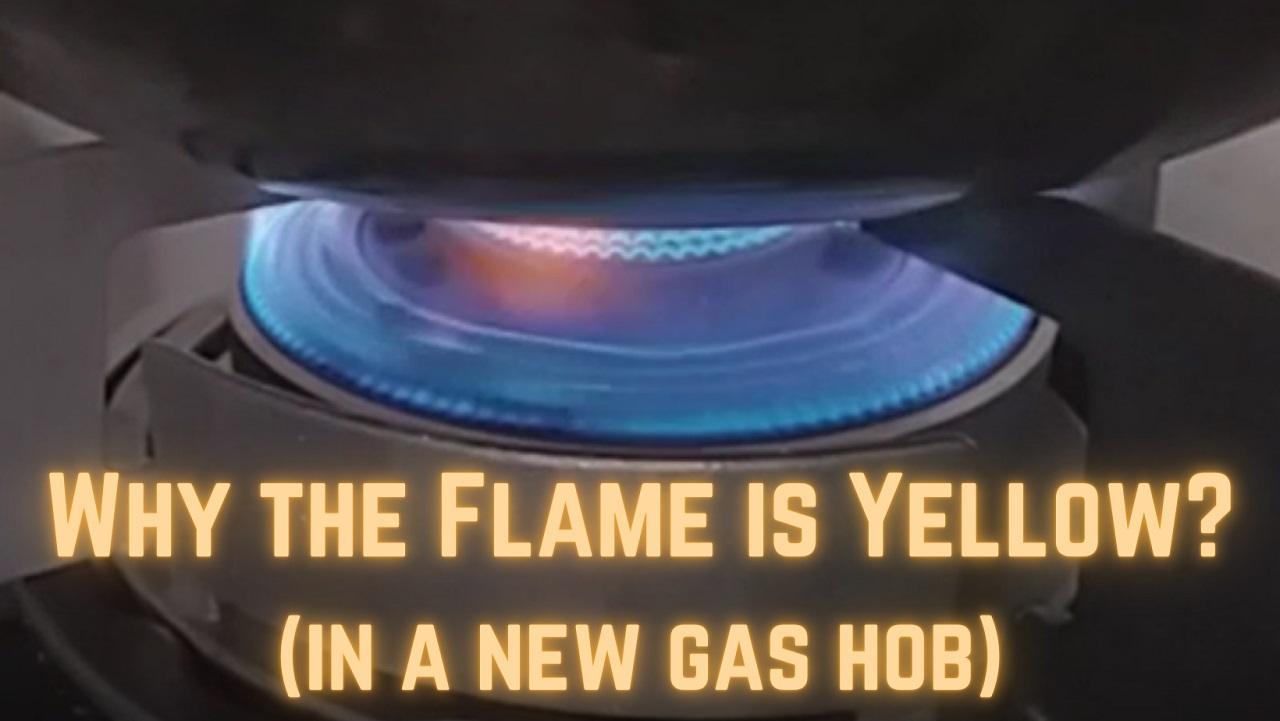There are many factors to consider why the flame is yellow on your newly purchased gas hob that needs to be rectified!
Though this kind of product is carefully tested and checked at the manufacturing sites…
There is a possibility that some units with issues such as the yellow flame could still pass through the rigid checking process.
In this article, I will walk you through the possible reasons.
They are based on experience while developing gas hobs for different clients.
And I’ll try to explain all of them in the simplest way possible for easy understanding.
This applies to both Built-in and Freestanding types of gas cookers.
Let’s get started!
Why the Flame is Yellow?
Many factors could affect the performance of a new gas hob which may result in having a yellow flame. The following are the most common reasons- High air humidity, Oxygen deficiency, Burner cap deformation, Spillages on or inside the burner cap, Wrong nozzle used, and Wrong type of gas used. These are some of the common factory defects, ambient limitations, and usage considerations that can cause a yellow flame.
1) Humidity of Air is High
One reason that the flame on a gas hob becomes yellow is because of the air with high humidity.
I am talking about the ambient air blowing in your kitchen.
Like in my current location where humidity is always high… when there’s wind I need to close the kitchen door and window to get a stable blue flame.
But this kind of phenomenon (yellow flame) may even be experienced with your cooker hood blowing air down, especially at higher fan speed.
I experience this using a slanted type 90cm cooker hood, so when cooking I will only use the lowest fan speed.
And here’s another good example;
Not related to air, but has something to do with water.
Put a wet pan on the gas burner and you will see yellow flame scattered all over.
But the blue flame will emerge back after the moisture at the bottom of the pan has dried out.
2) Oxygen deficiency for Burner
To have complete combustion (that results in blue flame in the case of gas hobs), the right amount of oxygen is needed.
And as mentioned, yellow flame denotes incomplete combustion and one probable cause is the lack of input air.
Most common gas hobs or gas cookers have a Bottom Air System.
Like in the below example image (this is for a double gas burner hob):
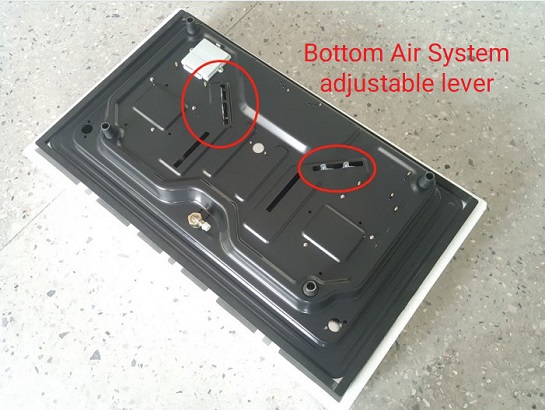
This is the bottom side of the gas hob and the parts that are marked can be adjusted to mix the right amount of air to get the best flame result and get a blue flame.
Every time the lever is adjusted you will notice changes in the flame’s performance (including the flame color).
Please note don’t touch this part if you have no experience doing it – Always refer to a Professional!
For high-rise buildings that have a centralized gas supply (normally natural gas), this is checked regularly by the gas technician.
Like in my place, the gas technician will verify the following;
- Gas meter
- Gas pressure
- Gas hob’s ignition system and flame
- Gas hob’s installation (checks the built-in cabinet to see if the gas hob has enough vent space)
3) Spillages on the Burner cap or Inside the Burner cap
Spillage is a common occurrence during cooking and spilled liquid will cause the flame to turn yellow!
The below spillage test was done for a gas hob developed for a particular market in Asia.
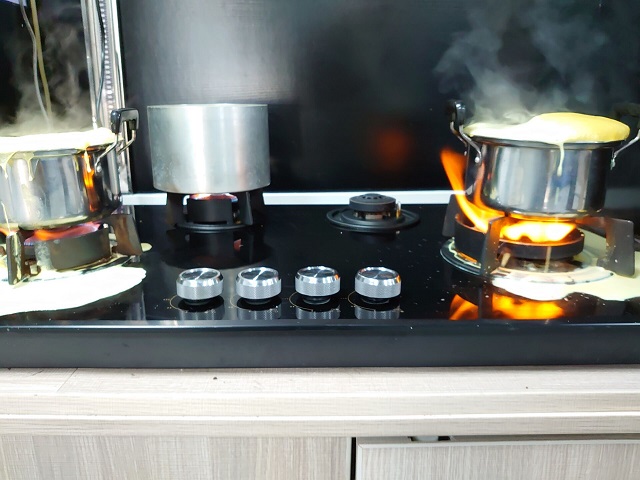
After the spillage has dried and if it remained on the burner cap uncleaned, rest assured that the flame will be yellow.
Likewise, spillage could enter inside and down the burner which could create blockage on the nozzles, which in turn could also cause a yellow flame.
4) Burner cap Deformation
Another cause of yellow flame is a deformation of parts such as burner caps and rings.
As flames directly pass through these parts, any obstruction will affect the performance of the flame.
And with the below example image, any deformation on this kind of burner cap design will affect flame performance and that includes flame color.
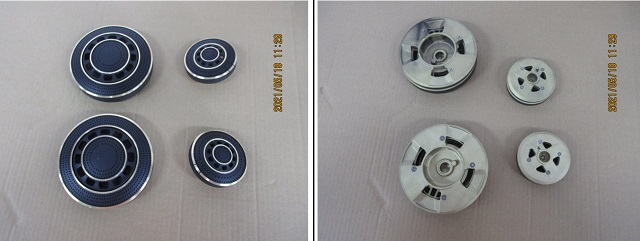
These parts are fixed by tapes to ensure it does not fall during transportation.
So, don’t try to drop these parts during installation as well as during cleaning as it could be a cause of a yellow flame.
If for any reason, a yellow flame does not appear in all of the burners…
One easy way to check – is to look for any physical damage on the burner cap or ring.
Then what you can do is to switch the burner cap and ring that produces yellow flame and fit it to another same-size burner to verify.
5) Used the Wrong Nozzle
Different nozzles are used in a gas hob. There’s the nozzle designed for LPG and a different nozzle for Natural gas type of gas cookers.
In the same manner, many gas cooker designs can use both nozzles- one that is already installed and the other nozzle type supplied as an accessory.
As an example,
The below image shows an installed nozzle for LPG (so by default, this gas hob is LPG type).
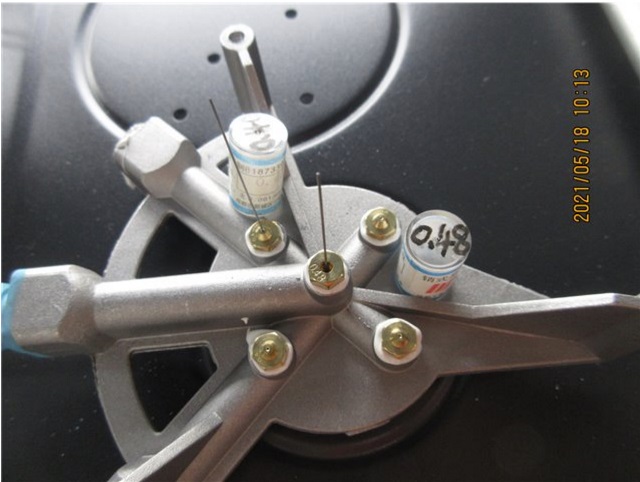
And based on the manufacturer and client’s agreement – there will be a supplied accessory nozzle for Natural gas… see the below image.
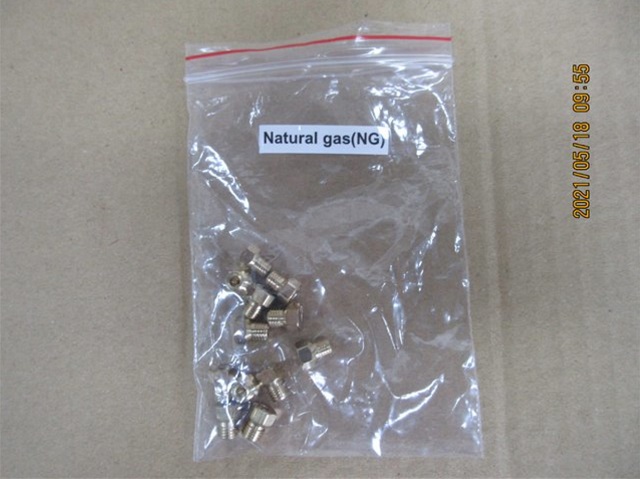
And in this kind of arrangement, there’s a possibility that the wrong nozzle could be mixed and used instead. Which could result in yellow flame because the diameter of the nozzle for LPG will be different for Natural gas nozzles.
6) Connected or Supplied the Wrong Gas type
This has a relation to the nozzle installed in the gas hob- and if the wrong type of gas is supplied, it will cause a yellow flame!
So, before buying a gas hob make sure to check what type of gas is supplied in your area.
As I mentioned earlier, most high-rise buildings have a centralized gas supply and it is normally Natural Gas (an example is in my place).
Or, decide first what type of gas you’re gonna be using in the absence of a centralized gas source.
Note that there are gas hobs that are designed for LPG only.
The same goes for gas cookers designed only for natural gas.
While there are gas cookers that can adapt both LPG and Natural gas,
BUT…
You must change the nozzle to match the type of gas connected to get desired blue flame.
Bear in mind that changing the nozzle needs expertise,
If you have no prior experience, never try to change the nozzle for safety reasons!
Always call a professional who can do it for you, or ask for support where you purchased your gas hob.
Related article ➡️ What is a Gas Hob and How it Works
Final Thoughts
We were able to establish reasons what causes the flame to become yellow even in a newly purchased gas hob.
To summarize, again they are the following:
- Humidity in the air is high
- Air input is insufficient or lacking
- Spillage ON and Inside burner caps
- Deformation on burner caps/rings
- Installed or used the wrong type of nozzle
- Connected or supplied the wrong type of gas
Please take note that to rectify yellow flame some of the methods need professional assistance, so don’t try to do it yourself.
Always refer back and request support from your gas hob dealer for SAFETY concerns.
Your main objective is to correct the yellow flame (which denotes incomplete combustion) and to achieve the desired Blue flame (which refers to complete combustion).
So, there you have it, folks.
Once again thank you for reading. If you find this article helpful or you have some questions please leave a comment below.
And I will try to answer them to the best of my knowledge.
